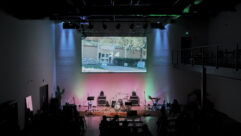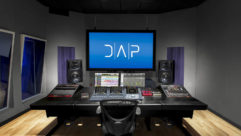Video pitfalls
May 1, 2000 12:00 PM,
Peter H. Putman
Flat-screen displays carry a number of attributes that will help you stayon the path to the perfect video installation, but they also carry someconcerns that, if left unattended, can bring disaster.
It should be pretty obvious to readers of S&VC that flat-matrix imagingtechnologies (LCDs, DLP and plasma) are approaching king-of-the-hill statuswhen it comes to the design, specification and installation of electronicdisplays. The projector market in particular has been turned upside-down bya flood of high-brightness, lightweight products. There is no reason toassume the same thing will not happen to the video and presentation monitormarkets. Considering what these products are replacing, we are alreadyreaping plenty of benefits. Gone is the need for heavy-duty installationbrackets. Gone, too, is the need for converging three-tube front-projectionsystems. High-gain front-projection screens and their associated hot-spotproblems and narrow viewing angles are also headed for the endangeredspecies list.
Plasma and LCD monitors bring similar advantages. Now, we can mountdirect-view monitors anywhere our heart desires. We can even uselow-profile recessed mounts. Heavy-duty carts? Forget about them. Highambient light levels? Not a problem. It would appear that there is noobvious downside to switching from tube to matrix imaging. As many dealersand systems integrators are finding out, however, flat-matrix displaysbring along their own problems, many of which are not that easy to solve.That is not to say that you should stay away from flat-matrix imaging. Farfrom it. What you should do is learn as much as you can about thecharacteristics of flat-matrix imaging and how different video and computersignals are processed by liquid-crystal displays (LCD), digital micromirrordevices (DMD) and gas plasma panels.
For plasma displays, the jury is still out on the use for continuousoperation with static graphics; existing public display installationssimply have not yet logged enough hours for us to draw specific conclusionsabout brightness levels and phosphor life.
By the number
The largest limiting factor to flat-matrix displays is their fixed imageresolution. By that, I mean the structures of pixels that constitute theactive imaging area. When we buy a display using picture tubes orprojection tubes, we have a vague idea of its resolution capability. Untilthat tube is turned on, though, it has no resolution whatsoever and waitsobediently to trace the desired horizontal and vertical dimensions for us.
Flat-matrix displays, on the other hand, have a specific, quantifiedresolution whether they are sitting in a box in a dealer’s stockroom orhanging from the ceiling in a conference room. As a result, flat-matrixdisplays always present their best image when displaying any input signalsthat precisely match that fixed resolution.
Signals that fall above or below the total pixel count of the display areproblematic because they must be electronically enlarged or reduced in sizeto fit the available imaging area. This re-sizing trick is not that easy topull off, and it requires some pretty smart digital signal processing onthe part of the manufacturer. There is also the question of aspect ratiosto deal with. High-resolution projection systems may have 1,280 infinity1,024 (5:4) or 1,365 infinity 1,024 (4:3) pixels for SXGA resolution, whichresults in either a horizontal squeeze of incoming signals or black bars onthe top or bottom of an image.
There is also the issue of lost image detail. Workstation resolutions, suchas 1,280 infinity 1,024 and 1,600 infinity 1,200, require a fair amount ofcompression when moving down to 1,024 infinity 768 pixels, resulting incharacter fragments, broken lines and loss of detail. These are all directresults of the need to compress data to fit the available imaging area, aproblem that did not exist with CRT imaging.
Video scaling presents its own headaches. In addition to the conversionfrom an interlaced signal in another component format, video images must beenlarged several times to fit 1,024 infinity 768 and 1,280 infinity 1,024displays. The usual result is a collection of digitally created motion andpixel artifacts that will be unsatisfactory to the customer. Again, no suchproblem exists with CRT imaging.
As if we did not have enough headaches already, along come plasma panelswith their wide aspect ratios and out-of-left-field pixel counts. Not onlydo we have to deal with video conversion and RGB pixel scaling, but we alsofrequently wind up with unused image area when viewing a steady diet of 4:3and 5:4 images. What customer wants to pay for 100% of a display and useonly 70% of it? Not many.
The low price points associated with many desktop and installationprojection systems do not allow for more than functional image scaling. Theobvious answer is to conduct a thorough test of the scaling performance ofthe desired projector or monitor as well as an investigation of theend-user’s screen resolution needs before making any promises. The goodnews is that some manufacturers are on top of the problem. I have foundcertain projectors that do an excellent job of resizing and processing RGBimages. Check out www.projectorexpert.com for more detailed information onspecific models.
It is also an excellent idea to add a quality third-party video/RGB scalaror scaling switchers for any flat-matrix installation. These boxes cansolve a multitude of problems and provide expansion for future signalformat headaches, such as digital television (DTV).
In the case of 16:9 native displays, such as plasma panels, the customershould be made fully aware of the format incompatibility with standardcomputer aspect ratios. At present, there are few video display cards forcomputers and workstations that support the Wide VGA (852 infinity 480 and853 infinity 480) and Wide XGA (1,280 infinity 768 and 1,365 infinity 768)plasma formats. Simply expanding the image digitally to fill the screen isbut a short-term solution that introduces image distortion.
Signal formats and timing
In one sense, the move to flat-matrix imaging could not have come at aworse time. That is because our new digital television system is in thelarval stage, and manufacturers seem pretty happy at present to go theirown way with regards to signal distribution formats and the interpretationof sync signals. While videophiles are content to stay in a world ofcomposite, component Y/C and component YUV video, computer display veteransare still juggling component (RGBHV), composite (RGBS) and sync-on-green(RGsB) formats. Now, the digital newcomer will rock the boat even more withyet another component signal format – YPbPr with tri-level or bi-level sync.
Systems integrators are finding more often than not that customers are atleast inquiring about, if not demanding outright, HDTV compatibility intheir next project. Some have even gone ahead and purchased set-top boxes(STBs) at consumer electronics retailers to take advantage of low pricesonly to discover a format incompatibility problem. One good example isRCA’s DTC-100 HDTV set-top box. From the standpoint of a consumer, it is adream come true – an all-in-one box that receives and decodes DTVbroadcasts off-air, over cable and off satellite (DirecTV). At a suggestedlist price of $650, it is the cheapest STB currently offered for sale.
From the standpoint of a systems integrator, particularly those in thehome-theater business, the DTC-100 is not a dream; it is a potentialnightmare. RCA has elected to use an output signal format more in line withthe computer display world – progressive-scan RGBHV signals with bi-levelsync through a 15-pin VGA style connector. The intent is to have customersbuy RCA’s matching TV sets and simply plug in the cables. Difficultiesarise because many Japanese display manufacturers have decided that 15-pinRGBHV/RGBS connections with bi-level sync are basically a computer signal,not an HDTV decoder. As a result, there is at least one 42 inch (1.1 m)plasma display that will interpret this format incorrectly, resulting in ajumbled picture.
Suffice it to say that third-party interface manufacturers will be busydeveloping products to transcode both color space and sync formats. In themeantime, it would be prudent to test any STBs to ensure both signal andcable compatibility. Of course, CRT imaging systems will readily acceptdecoded HDTV in just about any format without these preconceived notions.
As a rule, you should always check out the horizontal and vertical syncspecifications for a given flat-matrix device. A hands-on test is the bestway; just because manufacturers’ specs say a given projector or monitor canhandle horizontal sync up to 85 kHz does not mean that it will always doso. Restricted bandwidth and clock tracking errors may result in bandedimages, crushed images or no image whatsoever. I have tested frontprojectors that quickly synced up to any test format I threw at them whileothers sat there forever with “Perfecting Image” or “Adjusting Image”displayed on a blue field. Those are not messages your clients will want tosee often, if at all.
Once again, third-party manufacturers are coming to the rescue withoutboard scalars. These boxes can convert oddball signal formats to onestandard resolution, allowing no-glitch signal switching. More and moreclients demand seamless switching between signal format and couldn’t careless about bi-level and tri-level sync, not to mention RGBHV, YPbPr, RGsBor any other of that alphabet soup lingo.
The addition of dissolves and luminance/chrominance key functions toscaling switchers makes them all the more attractive, and it justifies theadditional cost in many customers’ minds. Multi-purpose rooms that displayvideo and computer images on a regular basis will benefit tremendously fromscaling switchers. Make sure to add one to the parts list for your nextflat-matrix installation project.
Projector life and death
Some of the more mundane aspects of flat-matrix imaging remain daunting.Now, instead of replacing projection tubes, we are replacing projectionlamps, and those lamps may not last as long as the manufacturer claims.When the first metal halide lamps came out in the mid 1990s, it was notunusual to hear claims of 2,000 to 3,000 hours before replacement. We nowknow that this figure is closer to 1,000 to 1,500 hours. The same holdstrue for the compact high-efficiency lamps (UHP and UHE). At one time, amanufacturer made the astounding claim of 8,000 hours of bulb life for aUHP lamp. That claim, of course, turned out to be substantially inflated,and a 2,000 to 4,000 hour span is considered to be far more reasonable.
Projection lamps give off heat and plenty of it. That means themanufacturer must address the often contrary design requirements of smallerform factors and greater cooling area. Sony has tackled this problem byusing cast magnesium housing for many of its projectors (in effect turningthe entire projector into a heat sink). Others have employed clever aircirculation systems and added more and more fans.
Projectors are also dust magnets; plain and true. It is likely that moreprojector problems will be caused by clogged or dirty air filters thananything else. Although sales and marketing literature entice potentialcustomers by claiming virtually unlimited installation capability, thetruth is that projectors need lots of cooling airflow. The brighter theimage, the more airflow that is needed.
Although it is true that an ultra-portable projector is bright enough tolight up a 100 inch (2.43 m) diagonal screen in a room with high ambientlight levels, chances are it will get hotter than a pistol if employed in arigorous duty cycle. You would be better off using a larger model projector- because it is installed anyway, size is not as important – that hasgreater cooling capacity.
If the projector is to be installed in a smoky environment, it will be atgreater risk. Many LCD projectors sold into restaurants and bars wheresmoking is allowed are already showing evidence of yellowing from nicotineresidue. A sealed airflow system is preferable here.
For environments where the projector is not readily accessible, choosing amodel with excess lumens capacity and running the lamp at reduced voltagewill boost lamp life considerably without compromising image brightness. A90 pound (41 kg) box rated at 4,000 lumens may make a better choice than a14 pound box (6.3 kg) rated at 2,000 lumens for this reason, particularlyin conditions requiring constant operation.
Phosphor life
Early adopters of plasma display technology have gotten some rude shocks inrecent years. Not only is there the issue of video image quality (a majorproblem that is being overcome slowly with scalars), but the life of thephosphors also turned out to be on the short side. As a result, imageburn-in and pixel failures were common.
The problem lies in the voltages used to switch plasma pixels on and off.Older models required several hundred volts to create the initial cellcharge, using much lower voltages to sustain charges. Newer models caninitiate the charge-discharge cycle with lower voltages, but individualpixels are being driven harder in some models to increase brightness.
I tested six current models last summer, and all but two suffered fromimage burn-in after less than 60 seconds. Bright images, such as desktopcomputer displays, are particular troublemakers, leaving a ghost image thatmay take several minutes to fade away completely. The problem is aggravatedas manufacturers drive pixels harder to boost image brightness, and it is adifficulty familiar to users of CRT monitors and projectors.
The answer lies in the intelligent control of ambient room lighting anddriving the panels at sustainable levels. Orbiting circuits, used topreserve CRT displays, are smart choices here. A few manufacturers areaddressing burn-in with reversing cell charge circuits, and at least one isplanning to include an orbiter function.
The jury is still out on the use of plasma displays for continuousoperation with static graphics; existing public display installationssimply have not yet logged enough hours for us to draw specific conclusionsabout brightness levels and phosphor life. If you are uncertain which wayto go, rear-projection systems using LCD or DLP light engines are saferchoices because the only likely failure, the lamp, will not be acatastrophic one.
Cabling
The last potential trouble area is in the area of cabling and connectors.Once again, the connector complement on many projectors and monitors islargely dictated by the blurring of consumer and professional among theAsian manufacturers. BNC jacks have all but disappeared from the majorityof desktop projection systems, although they are still offered oninstallation-grade projectors.
Plasma manufacturers are wishy-washy about connectors. Panasonic andToshiba have deserted BNCs in favor of 15-pin VGA HD jacks for RGBinterfacing and use the lowly RCA jack for connecting video and HDTV.Pioneer goes with both BNCs and RCA jacks, while only Sony provides a fullcomplement of BNCs and 15-pin jacks for systems integration.
NEC’s newest 42 inch and 50 inch (1.3 m) plasma displays offer both 5xBNCand 15-pin HD inputs, a departure from last year’s models that werestrictly RCA jacks. BNCs (and any other secure connection, like screw-in15-pin plugs) are preferred for installations where accessibility isrestricted or the installation environment is rigorous. RCA jacks and plugscan fail simply because of dirt buildup, corrosion or mechanical vibration.
The question of compatibility will become moot in the near future as moremanufacturers migrate to digital inputs such as PanelLink and IEEE-1394.Video connections will move to single-wire BNC ports as serial digitalvideo interfaces are increasingly supported. Both digital connector formatsoffer greater reliability when compared to RCA plugs, DIN plugs (anothercheap and fragile connector) and 15-pin VGA HD plugs.
The catch
Keep in mind that flat-matrix imaging is still in the infant stage. Manyproblems, such as scaling, false contouring on plasma panels, and phosphorburn-in, are being addressed with vigor. It is certain that with thecontinual drop in prices of microelectronics and increased density ofsemiconductors, high-quality image scaling will eventually reach a pointwhere it will add little to the cost of a projector or monitor.
Screen resolutions will continue to increase. Reflective LCD panels with2,048 infinity 1,536 resolution will be introduced by at least onemanufacturer this year, and transmissive 1,600 infinity 1,200 panels willprobably follow next year. DMD chips are already at 1,280 infinity 1,024,and 1,600 infinity 1,200 is the next likely step for them. Scaling willbecome less of a problem as virtually all signal formats will beupconverted, not downconverted.
Plasma panels will not change much in resolution, but their video scalingand sampling circuits will see great improvements. The familiar moss effectseen from dynamic false contouring will eventually be eliminated with pixelredesign and addressing. Concurrent with these developments will be a dropin the price of plasma glass, making them more competitive with CRTs.Burn-in will still be a problem for some time to come.
Large LCD monitors are also challenging the primacy of CRTs in a battlethat they are expected to eventually win. The same scaling tricks will beapplied to these 25 inch (635 mm) to 30 inch (762 mm) flat panels, whichare already displacing CRT monitors in many applications. LCD panels arealready available with resolutions as high as 1,600 infinity 1,200, andthat number will increase. Best of all, LCD panels do not suffer from imageburn-in.
We should face it – flat-matrix displays are here to stay, and they areforcing changes in systems integration business models because of theirlower prices and simpler installation and operation requirements. Yourcustomers will be asking for them in increasing numbers. The trick for youwill be to make these displays interface smoothly and look their best.










